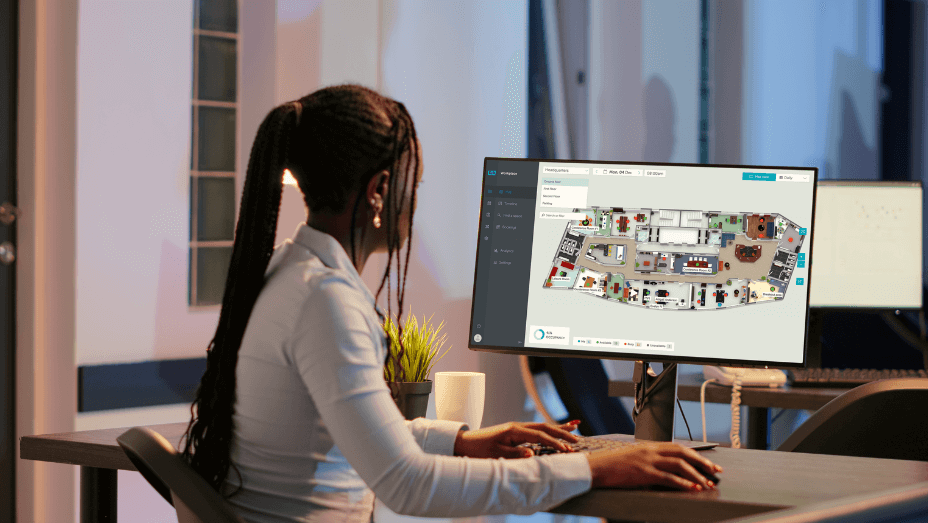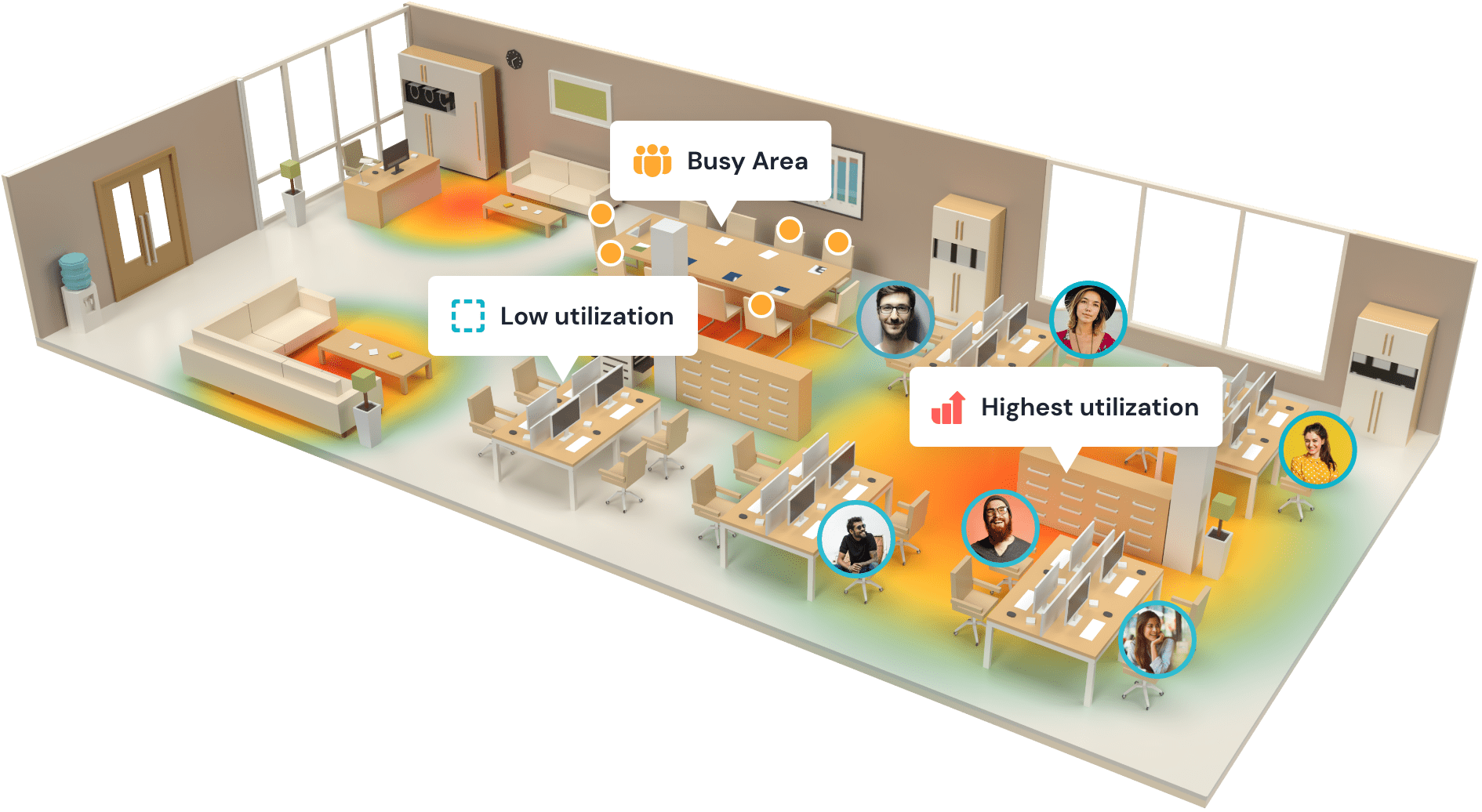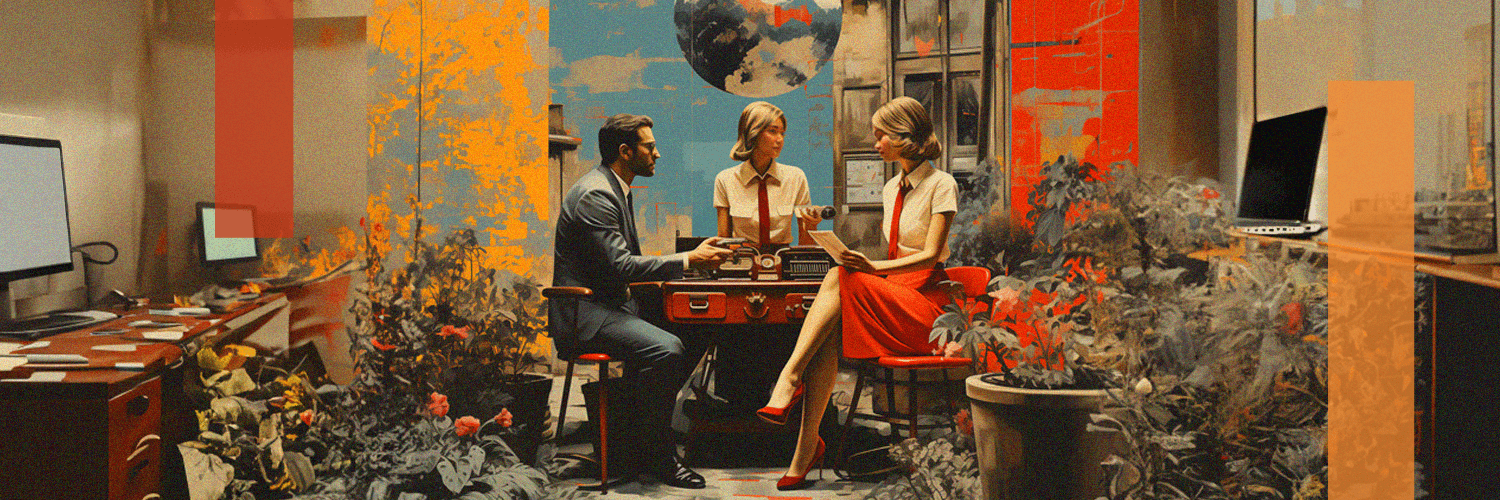Welcome to the future of work, where friction is no longer a necessary evil!
More and more companies are discovering that a seamless and frictionless workplace design is the key to success these days. That's why we’re taking a look at the different elements that contribute to a smooth and optimized working environment where employees can thrive without unnecessary obstacles that limit their productivity – from efficient workplace management to flexible working arrangements. Let’s get started!
TL;DR:
- A frictionless workplace aims to remove unnecessary hurdles in the working environment so that employees can perform at their best without being hindered by logistical challenges or inefficient processes.
- Creating a frictionless workplace requires prioritizing human factors, encouraging open communication, supporting flexible work arrangements, leveraging workplace data, integrating efficient technology, and seeking continuous feedback for improvement.
- Efficient workspace management, easy wayfinding and flexible work design are some examples of frictionless workplace experiences. But the future of the frictionless workplace also includes trends such as automation, AI integration and the continued rise of remote working.
- While it's important to think ahead, recognizing and eliminating friction points (such as inefficient processes and poor communication) is also an important aspect of creating a frictionless workplace.
What Is a Frictionless Workplace?
In the broadest sense, frictionless means that an experience or process is effortless and without resistance. Imagine a smooth journey where everything fits in seamlessly and all unnecessary obstacles along the way are removed! Now imagine applying this concept to your day–to-day work – sounds great, right?
In the context of the workplace, a frictionless environment means removing the obstacles that stand in the way of productivity and efficiency. This requires optimizing systems, processes and communication channels to ensure a smooth workflow and create a place where employees can collaborate effortlessly, share ideas freely and access resources easily… oh yes – sorry, we got distracted! – and can focus on their tasks without distraction. Think of it as streamlining processes so everyone can do their best work.
Of course, a truly frictionless workplace is an ongoing journey, not a destination. It requires constant evaluation and adaptation to evolving needs and technologies, with employee satisfaction and engagement at the forefront. But even if perfection is hard to achieve, it's definitely worth striving for!
Examples of Frictionless Workplace Experience
Efficient workspace management, simple office wayfinding systems and flexible working arrangements are just a few examples of how companies can offer their employees a seamless workplace experience.
Efficient Workspace Management
Efficient workspace management means ensuring that employees have access to the resources they need when they need them – be it equipment, tools or even spacious meeting rooms. By streamlining these processes and making them easily accessible, organizations can reduce time wasted searching for items and increase productivity and collaboration.
Think about the last time you struggled with overlapping desk or meeting room bookings. Not nice, right? Well, a workplace without these problems can actually exist – it’s called 'frictionless'!
Easy Wayfinding
Easy wayfinding is another great way to keep the workplace running smoothly. Finding your way around a large office can be time-consuming and frustrating if employees are constantly getting lost or confused. With clear signage, interactive office maps or digital wayfinding, companies can ensure that their employees can easily get to where they need to be without wasting valuable time.
Imagine no longer having to search for your colleagues or a specific meeting room until you get dizzy – it's possible! In a frictionless workplace, you can find them quickly!

Yarooms interactive office map allows you to select location, floors, and even date and time to check the real-time or future space availability and book a room. You can also search for rooms with specific amenities and locate your colleagues within the office. Learn more about Yarooms office maps.
Flexible Work Arrangements
Flexible working arrangements also contribute to a frictionless workplace experience. If employees can decide for themselves where and when they work, set up their own working hours digitally and view those of their colleagues, they can find a balance that suits their individual needs and preferences.
Whether they work part-time or adapt their working hours to personal commitments, flexible working arrangements promote employee satisfaction and reduce unnecessary stress, resulting in a far smoother work environment.
Identifying Friction Points in the Workplace
Friction points are the areas where employees tend to encounter obstacles or challenges that affect their productivity and overall work experience, in case you were wondering (and we’re sure we can all think of a few examples…).
One common friction point is inefficient processes. This could be outdated systems or workflows that slow down tasks and waste people’s time. By streamlining these processes and implementing automation where possible, companies can eliminate unnecessary steps and help everyone work more efficiently.
Another source of friction can be poor communication channels. When information doesn't flow freely or effectively between team members, misunderstandings occur, leading to delays in decision-making and project execution. It's therefore important to ensure open communication channels at all times!
Workspace design can also contribute to friction within an organization. A cluttered or disorganized office environment can easily lead to distractions. A well-designed workspace with sufficient storage space can help employees focus on their tasks without unnecessary interruptions.
Next, there is the workplace culture. If there’s a lack of trust among colleagues or if individuals feel undervalued or unsupported by management, this can lead to tension within the team. Building a positive company culture that emphasizes teamwork, respect and recognition can help alleviate these problems.
And finally, there's a workload imbalance. An uneven distribution of tasks not only affects individual morale, but also has an impact on team dynamics, as some members may feel overwhelmed. Regularly reviewing the distribution of work ensures fairness across the team and maximizes productivity at the same time
A 6-Step Roadmap to a Frictionless Workplace:
Creating a frictionless workplace starts with prioritizing human factors – but that's not all! Here’s a comprehensive 6-step roadmap to help you create one yourself:
Prioritizing Human Factors for a Frictionless Workplace
Prioritizing human factors is the first step to creating a frictionless workplace. After all, people are the heart and soul of any organization. By understanding and responding to their needs, we can pave the way for a smoother and more productive work environment.
- One aspect of considering human factors is ensuring that employees feel valued and supported. This means providing them with opportunities for growth and fostering a culture of open communication and feedback.
- Another one is creating an inclusive workplace that values diversity. By embracing different perspectives, backgrounds and experiences, organizations can tap into a wealth of ideas that can drive innovation and problem solving.
- It's also important to create spaces that promote comfort and wellbeing. From ergonomic furniture to adjustable lighting, investing in employee comfort can help avoid unnecessary distractions or discomfort.
- In addition, flexibility should be embedded in the organizational structure. Allowing employees to manage their own time not only improves work-life balance, but also gives them the opportunity to optimize their productivity levels.
Practicing Frictionless Communication for Enhanced Collaboration
Frictionless communication is about removing barriers and optimizing the exchange of information. This means using clear and concise language, choosing the right channels for different types of communication and creating an environment where everyone feels comfortable expressing their thoughts and ideas.
- One way to achieve frictionless communication is to use tools and platforms that enable real-time communication. This can remove barriers caused by time zones or physical distance.
- Another way is to actively listen to the perspectives of others and encourage an open dialog in which different opinions can be freely exchanged, leading to more innovative solutions.
- Clear expectations regarding response times also help to avoid delays or misunderstandings caused by slow or missed communication.
- In virtual meetings or remote work scenarios, video conferencing platforms helps to maintain face-to-face interaction and avoid potential misinterpretation of written messages.
Embracing a Flexible Approach to In-Office versus Remote Work
Gone are the days when everyone had to be in the office from morning to evening. With technological advancements and changing work dynamics, organizations today are moving towards more flexibility in where and how their employees work to create a seamless working environment.
By taking advantage of this flexibility, companies can tap into a wider talent pool as geographical boundaries are no longer a barrier. Employees can also achieve a better work-life balance as they no longer have to commute as long and have more control over their schedules.
Of course, managing remote teams requires trust, effective communication tools and processes, as well as clear expectations and regular meetings to ensure everyone meets their goals and deadlines.
A flexible approach allows organizations to adapt to changing times, empower employees to determine how they work best, and increase productivity, engagement and overall job satisfaction – all ingredients for success!
Leveraging Workplace Data for Informed Decision-Making
Analyzing data on employee behavior, space utilization and bottlenecks in workflows can provide valuable insights for companies looking for ways to improve.
For example, you might find that certain teams are consistently booking larger meeting rooms than they actually need, or that certain areas of your office are underutilized.
With these insights, you can then make strategic decisions to optimize your workplace design and resources. You can decide to redesign the office space to fit your team's needs or invest in additional co-working spaces if demand is high. This will not only increase efficiency, but also employee engagement by providing them with the right tools and environment.
By continuously collecting and analyzing workplace data, companies can make decisions based on facts rather than relying solely on intuition or assumptions.

The Yarooms office utilization report shows key metrics like average space use, no-shows, and bookings. Employing an intuitive heat map, location managers gain insights into areas of underutilization, empowering them to refine office optimization strategies. Discover Yarooms workplace analytics.
Integrating the Right Technology for Increased Efficiency
Choosing technology solutions aligned with business goals is also important. It's critical that technology simplifies tasks rather than complicates them, and that it's carefully selected according to specific requirements.
A comprehensive workplace experience platform like Yarooms is a cornerstone of this integration. It provides interactive office maps that make it easy to find resources, room booking features that eliminate scheduling issues, and a flexible work calendar that gives employees control over their schedules.
By capturing and analyzing data on workspace usage, companies can also identify inefficiencies and optimize resources to reduce costs and maximize productivity.
Seamless collaboration tools should also be integrated to enable effective communication between team members regardless of their location or working conditions. From video conferencing to project management software, these tools promote collaboration in hybrid and remote workplaces.
CTA banner: 3 minute demo
Asking the Right Questions: Feedback & Continuous Improvement
When organizations ask the right questions, they gain valuable insights into the effectiveness of tools and processes and can make data-driven decisions for continuous improvement. This ensures that the workplace evolves in line with the changing needs and preferences of employees.
Incorporating employee feedback into decision-making demonstrates a commitment to a workplace that prioritizes the individual needs of team members. This not only boosts morale, but also employee engagement because they feel heard and valued.
In addition, consistently soliciting feedback serves as a proactive measure to identify potential problems in work processes. This preventative approach allows companies to address issues promptly and fosters a sense of transparency and openness, building trust between employees and management.
The focus on adapting the workplace to individual needs, which becomes apparent through feedback-driven improvements, plays a crucial role in creating a working environment that is not only efficient, but also promotes employee wellbeing.
Frictionless Workplace Experience at Dr. Martens for Yarooms: A Case Study
Dr. Martens, the iconic footwear brand, recognized the need to create a frictionless workplace experience for its employees. With multiple offices and a growing number of employees, it was important to manage the workplace efficiently and improve collaboration.
With Yarooms interactive office plans and powerful room booking engine, employees were able to choose their own workspace according to their preferences and needs.
The flexible working calendar provided further convenience by allowing employees to plan their working days according to their personal circumstances. This not only increased productivity, but also improved work-life balance.
And, with access to real-time data analytics provided by Yarooms, decision makers at Dr. Martens were able to make informed decisions about workplace utilization and resource allocation.
Integrating the right technology played a key role in creating a seamless experience across the company's premises, encouraging collaboration between teams in different locations and increasing employee satisfaction at Dr. Martens to ultimately achieve better results overall.
The Future of Frictionless Workplaces
The future of the frictionless workplace holds immense potential to transform the way we work. As technology evolves, so will our ability to create seamless and efficient experiences for our employees.
An important aspect of the future workplace is likely to be automation. By automating repetitive tasks and streamlining processes, companies can eliminate unnecessary friction and allow employees to focus on more meaningful tasks. This not only increases productivity, but also employee satisfaction.
Another important trend for the future of the frictionless workplace is the integration of artificial intelligence (AI) and machine learning. These technologies can help identify patterns and trends in data so that companies can make better decisions about resource allocation, scheduling and workflow optimization.
In addition, the rise of remote working will continue to change the workplace landscape. Increasingly, teams will be able to collaborate seamlessly regardless of their location. This flexibility not only empowers employees, but also gives companies the ability to tap into a global talent pool.
By proactively embracing these advances, companies can stay ahead of the curve by creating an environment that prioritizes efficiency, effectiveness and employee wellbeing
Becoming a Forward-Facing Company. Reaping the Benefits of a Frictionless Workplace
In today's fast-paced and competitive business world, companies must constantly innovate and adapt to stay ahead. An important aspect of this is creating a frictionless workplace that promotes efficiency, collaboration and employee satisfaction.
By prioritizing human factors, practicing frictionless communication, implementing flexible work arrangements, leveraging workplace data, integrating the right technology and soliciting feedback for continuous improvement, companies can pave the way to a truly frictionless workplace.












